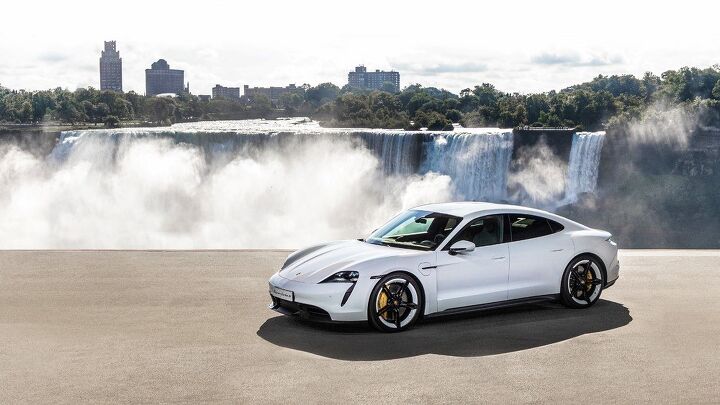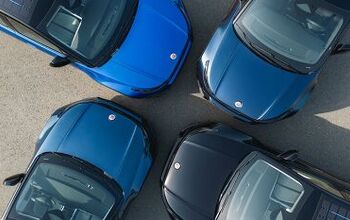Porsche Taycan - EV Halo Car, or Gut Punch for Tesla?

Perhaps it’s both. After four long years of teasing, Porsche pulled the wraps off its Taycan electric car on Wednesday, lifting the sheet at a glitzy affair overlooking Niagara Falls.
The four-door EV is sleek, sensuous, fast, expensive, and without a doubt Tesla’s worst nightmare. Why mention the chief rival of Porsche’s new offering? Well, because Tesla’s Model S 100D came first, and it’s still a significant money-maker for the hard-pressed automaker. But Porsche is Porsche — status comes standard with each purchase, and the Taycan brings that desirable badge into the growing realm of hot electrics.
So, what does the Taycan offer?
Launching in two top-trim guises, Taycan Turbo and Turbo S (there’s obviously no actual turbocharger), the Taycan draws upon a 93.4 kWh battery pack that gives the 5,100-plus-pound car a lower center of gravity than the revered Porsche 911.
The Turbo is good for 670 horsepower, every pony of which comes online with launch control engaged, while the Turbo S puts out 750 hp in the same manner. Dual motor and all-wheel drive is the only way to go with these two brutes, helping the models rocket to 60 miles per hour in 2.6 and 3 seconds, respectively. While both models top out at 161 mph, attempting to reach such speeds won’t do anything good for your battery range or your driver’s license.
Unlike most other electrics, Porsche makes use of a two-speed transmission in the Taycan. The gearbox aims to maximize acceleration while still ensuring easy and efficient high-speed cruising.
Porsche engineers went to town on the Taycan’s slippery shape, ensuring a coefficient of drag as low as 0.22 for the Turbo model (0.25 for Turbo S), while other members of the development pit crew ensured rapid recharging via the car’s novel 800-volt system. Assuming optimum charging conditions and the fastest plug-in on the market (270 kW), a Taycan can charge from 5 to 80 percent in 22.5 minutes, Porsche claims. There’s still the option of plugging into a household outlet.
Technological prowess aside, Porsche knew putting the car first and passengers second wouldn’t bode well for its reputation. Thus, engineers built “foot garages” into the rear-seat footwells — dents in the battery pack, essentially — to ensure backseat passengers received a decent amount of legroom. A 10.9-inch infotainment screen and optional passenger screen take up part of the Taycan’s minimalist dash, which reduces the number of buttons, dials, and switches for a cleaner, more modern look.
Cargo space resides both front and rear, with a 2.8 cubic-foot cubby up front and a more generous 12.9 cubic-foot area out back.
Hidden within each wheel well is a hydraulic brake system Porsche claims you’ll seldom need to use. The car’s regenerative capacity can handle up to 90 percent of the vehicle’s braking, meaning Taycan owners might only make use of that left pedal in sudden-stop situations. Also hidden in those wells is a standard adaptive air suspension, with Porsche Dynamic Chassis Control Sport electromechanical roll stabilization system and Porsche Torque Vectoring Plus available for spendthrift buyers.
Four drive modes span the gamut between balls-out power and energy conservation. Wheel size is an appropriately large 20 inches on the Turbo and 21 inches on the Turbo S.
While the Taycan is undoubtedly an impressive green machine, it doesn’t come cheap. The Taycan Turbo starts north of $150k ($150,900, to be precise), well above the MSRP of a Model S, while the Turbo S can’t be had below $185,000. The automaker aims to release lesser versions in the future, with rear-drive and a sub-$100k price tempting buyers of lesser means. When and if those models appear remains to be seen.
Range also remains to be seen; Porsche didn’t have any EPA numbers on hand for today’s launch, though the automaker’s concurrent European event saw a figure of 280 miles mentioned (keep in mind, these are Euro figures that’ll surely be pared back in the U.S.). That’s significantly less that the range of a top-shelf Tesla. Expect to hear firm numbers as the model’s late 2019 on-sale date draws closer.
[Images: Porsche AG]

More by Steph Willems
Latest Car Reviews
Read moreLatest Product Reviews
Read moreRecent Comments
- Varezhka I have still yet to see a Malibu on the road that didn't have a rental sticker. So yeah, GM probably lost money on every one they sold but kept it to boost their CAFE numbers.I'm personally happy that I no longer have to dread being "upgraded" to a Maxima or a Malibu anymore. And thankfully Altima is also on its way out.
- Tassos Under incompetent, affirmative action hire Mary Barra, GM has been shooting itself in the foot on a daily basis.Whether the Malibu cancellation has been one of these shootings is NOT obvious at all.GM should be run as a PROFITABLE BUSINESS and NOT as an outfit that satisfies everybody and his mother in law's pet preferences.IF the Malibu was UNPROFITABLE, it SHOULD be canceled.More generally, if its SEGMENT is Unprofitable, and HALF the makers cancel their midsize sedans, not only will it lead to the SURVIVAL OF THE FITTEST ones, but the survivors will obviously be more profitable if the LOSERS were kept being produced and the SMALL PIE of midsize sedans would yield slim pickings for every participant.SO NO, I APPROVE of the demise of the unprofitable Malibu, and hope Nissan does the same to the Altima, Hyundai with the SOnata, Mazda with the Mazda 6, and as many others as it takes to make the REMAINING players, like the Excellent, sporty Accord and the Bulletproof Reliable, cheap to maintain CAMRY, more profitable and affordable.
- GregLocock Car companies can only really sell cars that people who are new car buyers will pay a profitable price for. As it turns out fewer and fewer new car buyers want sedans. Large sedans can be nice to drive, certainly, but the number of new car buyers (the only ones that matter in this discussion) are prepared to sacrifice steering and handling for more obvious things like passenger and cargo space, or even some attempt at off roading. We know US new car buyers don't really care about handling because they fell for FWD in large cars.
- Slavuta Why is everybody sweating? Like sedans? - go buy one. Better - 2. Let CRV/RAV rust on the dealer lot. I have 3 sedans on the driveway. My neighbor - 2. Neighbors on each of our other side - 8 SUVs.
- Theflyersfan With sedans, especially, I wonder how many of those sales are to rental fleets. With the exception of the Civic and Accord, there are still rows of sedans mixed in with the RAV4s at every airport rental lot. I doubt the breakdown in sales is publicly published, so who knows... GM isn't out of the sedan business - Cadillac exists and I can't believe I'm typing this but they are actually decent - and I think they are making a huge mistake, especially if there's an extended oil price hike (cough...Iran...cough) and people want smaller and hybrids. But if one is only tied to the quarterly shareholder reports and not trends and the big picture, bad decisions like this get made.






































Comments
Join the conversation
They called it 'turbo,' I refuse to acknowledge its existence.
I am encouraged to see that the two-speed transmission for BEV's is technically possible, since other manufacturers planned to introduce this and ended up canceling it. Note to EV critics: While you've been mocking Tesla, Porsche has been working to catch up with them. What Porsche knows that many enthusiasts don't: At some point, enough range is enough. Goofy things (which won't affect the success of this vehicle at all): - The 'turbo' name - The clear plastic charging cover (which presumably mimics a clear engine cover, but which will yellow over time) - Porsche has joined the touchscreen world (for better and for worse) What Porsche knows that most mainstream OEM's do not know: Lower price is not always preferable.